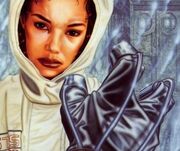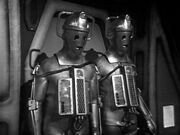- You may be looking for Faction Paradox.
The CyberFaction, also designated as simply the Faction by the history computer, were a particular group of Cyberman. They stood in contrast to CyberMondans.
Whereas the Mondans wished to retain some connection to their biological form, the Faction saw greater logic in fully embracing cybernetics. They thus retained a smaller percentage of their organic systems than Mondans. (PROSE: Iceberg) The Faction were identified as “CyberFaction” by the ArcHivists. ArcHivist Hegelia identified two distinct Cyber-body types amongst the CyberFaction: the "Early CyberFaction" whom waged the first recorded invasion of Earth in the late 20th century, and the "Late CyberFaction" whom attacked Space Station W3 in the late 21st century. (AUDIO: The Early Cybermen)
Characteristics
Early CyberFaction
As observed by ArcHivist Hegelia, the Cybermen of the "Early CyberFaction" boasted powerful cybernetic limbs whose movements were guided by intricate links of exoskeletal rods, allowing them to stride purposely towards their objective. On each side of the Cyber-helmet were muff-like striated headblocks, out of which protrude antennae, which Hegelia suggested were audio-sensing devices. These side handles bent upwards, then inwards then connected with the bulge at the top of the cranium. On the blank faceplate were two blank holes in the place of eyes. At each eye, a tear drop shape was etched where no tear had ever welled. The slit for a mouth portrayed no expression apart from cold resolve and the chin beneath fell weakly away to a thick, smooth neck. At the chest, there was mounted a bulky multi-purpose device whose central column was topped by a lense which projected deadly rays. The rest of the column was given over to four control knobs. On either side were vented wings, which Hegelia took to suggest further functions of the unit including respiratory aid, cleansing fliter, cooling equipment and energy pack. (AUDIO: The Early Cybermen, TV: The Invasion)
Late CyberFaction
As observed by Hegelia, there was a direct correspondence between the "Late CyberFaction" and their predecessors. However, there were also several differences. The striated headblock blocks on each side of the head were gone. In addition to larger tear drop holes at the eyes, there was also one at the mouth slit. Exoskeletal supports to the limbs had become less delicate with series of rods powered by blocks at the limb joints. Fibrillary piping extended from top to bottom of the chest units. Most significantly, their Cyber-hands were no longer clearly five-fingered, with closer scrutiny reveal that a three-fingered hand was formed out of what was originally a five fingered hand; each of two pairs of fingers were forced together into single channels and topped with a metal cap while the thumb, similarly capped, mades up the third finger. Unlike the early CyberFaction, the exoskeletal powering rods now longer stopped but extended to the three fingers. Recalling that the original CyberMondasians retained use of the human hands, nerves, tendons, muscles, stimulated directly perhaps by a cybernetically assisted arm, Hegelia suggested that, having become independent of Mondas, CyberFaction evolved further from the human form and encased the hand in the armoured material which now covered the entire body. She further reasoned that these organic remnants were losing their capacity to be stimulated and so were evolved into the more easily synthesised and less intricate three-fingered variety. Later, more sophisticated CyberNomads would achieve full five finger synthesis. (AUDIO: The Early Cybermen, TV: The Wheel in Space)
Technology
The late CyberFaction used Cybermats with photoreceptors for eyes rather than crystal-based eyes, spines down their backs and lacked the antennae. Otherwise, they looked similar to the Cybermats used by the CyberTelosians. (TV: The Wheel in Space)
History
Origin
Thousands of years before the 20th century, the Faction left Mondas for Planet 14. (PROSE: Iceberg)
20th century
The first invasion
In 1969, (PROSE: Who Killed Kennedy) 1970, (PROSE: No Future, Killing Ground) 1975, (AUDIO: Last of the Cybermen) or the late 1970s; (TV: The Web of Fear, The Invasion) the Faction put into motion what would later be recorded as the first attempted Cyberman invasion of Earth. (PROSE: Iceberg)
Prior to coming to Earth, the Faction had invaded the planet Isos II and converted its humanoid population into Cybermen. By repurposing Isos II's monorail system, a dimensional warp was created which led to Earth. A large invasion fleet of Cybermen waited on Isos II while a smaller amount of Cybermen and a Cyber-Planner went through the warp to establish themselves on Earth and put the planet into a weakened state. (AUDIO: The Isos Network)
After several years, (PROSE: Prelude Iceberg) they had established a base on the dark side of Earth's Moon. The Cyber-Planner had contacted the industrialist Tobias Vaughn, the head of the International Electromatics corporation. Vaughn installed mind control circuits in his company's appliances, paving the way for an invasion. He also grafted cybernetic arms onto several of his workers.
Vaughn had a Cyber-Planner installed in his office. The plot was uncovered by the newly formed UNIT and the Second Doctor, who helped avert the invasion on the Earth and at the Cyberman base on the Moon. (TV: The Invasion) The invasion fleet from Isos II came to Earth when the planet was put under cybercontrol by radio waves from IE products, but it was destroyed in a chain reaction started by missiles fired by UNIT. (TV: The Invasion, AUDIO: The Isos Network)
Aftermath
Bits and pieces of damaged Cybermen remained in the London sewers. One Cyberman managed to cannibalise garbage it found in the sewers to repair itself and create a considerable amount of Cybermats. The Third Doctor and Jo Grant stopped it from infecting an entire hospital with cybermites. (PROSE: The Piper)
In 1975, two Cyberman heads were found in the sewers; one from Deffry Vale station was sent to the Leamington Spa Lifeboat Museum (GAME: Security Bot) while the other head would eventually end up in Henry van Statten's Vault. (TV: Dalek)
Some Cybermen survived the destruction of the invasion fleet. Many were propelled into deep space. One Cybership crashed in Antarctica, where it remained frozen and hidden for two decades. (PROSE: Iceberg) Another Cybership managed to escape back to Isos II. The Second Doctor, Jamie McCrimmon, and Zoe Heriot followed the ship and destroyed all traces of the Cybermen on Isos II. (AUDIO: The Isos Network)
Vaughn survived his apparent death by transmitting his mind into a robotic copy of himself created with cybertechnology. For many centuries, Vaughn continued to influence Earth while repairing his robotic body with parts salvaged from failed Cyberman attacks on humanity. (PROSE: Original Sin, AUDIO: Original Sin)

Liz Shaw, Gareth Arnold, and Alistair Gordon Lethbridge-Stewart. (AUDIO: The Blue Tooth)
In the 1970s, Gareth Arnold uncovered a Cyberman ship that had crashed in Cambridge many years beforehand and experimented with the technology that had survived. Using Cybermats, Arnold attempted to convert all of Cambridge, but was stopped by the Third Doctor. During this incident, Liz Shaw was almost converted. The Cybermen that Arnold had created went into stasis on the ship, awaiting an activation signal. (AUDIO: The Blue Tooth)
The Faction had been opposed to the plan of the Mondans to pilot Mondas back to Earth to rob their twin planet of its energy. When that plan failed in 1986, and Mondas exploded, the Faction were apparently the only group of Mondasian Cybermen left in existence. They thus emerged as the "victorious" branch of the Cyber race. (PROSE: Iceberg)
21st century
Early 21st century

A Cyberman reaches towards Ruby Duvall. (PROSE: Iceberg)
In December 2006, exactly 20 years after Mondas returned to Earth, Cybermen of the Faction who had been in hiding in the South Pole since the International Electromatics invasion attempted to sabotage the FLIPback project and take over the Earth in the ensuing chaos. With the help of Ruby Duvall, the Seventh Doctor prevented the Cybermen from carrying out their plan and destroyed them. (PROSE: Iceberg)
UNIT has a cyber-helmet from the International Electromatics invasion at the Underbase. (COMIC: The Age of Ice) Kate Stewart had another leftover cyber-helmet. (TV: Death in Heaven)
Late 21st century

Cybermen of the "Late CyberFaction". (TV: The Wheel in Space)
By 2079, (AUDIO: Second Chances) the Second Doctor was "known and recorded as an enemy of the Cybermen". In this year, Space Station W3 was the site of a takeover by the Faction, but were defeated by the Second Doctor. (TV: The Wheel in Space)
22nd century
By the speculations of Hegelia of the ArcHive, a further group of Cybermen diverged from the Planet 14 Cybermen and became the CyberNomads. (PROSE: Killing Ground)
Other references
In the video game Happy Deathday, played by Izzy Sinclair on the Time-Space Visualiser, a Cyberman of Early CyberFaction was among a host of "every single enemy" that the Doctor had ever defeated, who were assembled by the Beige Guardian and pitted against the Doctor's first eight incarnations. (COMIC: Happy Deathday)
Behind the scenes
It should be taken into account that the term "CyberFaction" is used throughout in the narrative of The ArcHive Tapes.
The term "the Faction" has its origins in the non-narrative encyclopaedic book, Doctor Who: Cybermen, by David Banks. Among the terms and theories invented by Banks to explain the variations in the costumes (worn by Banks and his fellow Cyber-performers over the years) was that of "the CyberFaction". None of Banks's proposed terms garnered much attention amongst DWU authors, and weren't carried forward in narratives until Banks's own novel Iceberg.
While Iceberg did introduce many of Banks's earlier-stated concepts into Doctor Who fiction proper, it is worth noting that even he failed to use his own coinage ‘CyberFaction’ in said novel, with the Cybermen in question being only referred to as ‘the Faction’. Even then, Banks remained the only author ever to speak of “the Faction”, for all that his treatment of said Faction implies that a vast majority of the Cybermen encountered by the Doctor up until then had belonged to said Faction.
Other Faction-related facts from Doctor Who: Cybermen not reinstated anywhere in fiction include the idea that after the destruction of Mondas, parts of the Faction became CyberNomads and left Sol to explore Mutter's Spiral; and that following the attack on the Gravitron, the Faction abandoned the Sol system and journey into the galaxy to colonise a suitable planet, eventually landing on Telos, which they colonised in 2175, resulting in ‘CyberTelosians’, thus accounting for the apparently-native Telos Cybermen in The Tomb of the Cybermen in the same way suggested by Attack of the Cybermen three years prior — namely, that the Cybermen in question had actually been the results of Mondasian Cybermen taking over the planet.
Neither of these events are taken into account by this Wiki, as Doctor Who: Cybermen, being non-narrative, is not considered a valid source here.
Other matters
- A Cyberman from the "late CyberFaction" from The Wheel in Space features on the cover of PROSE: Illegal Alien.
- The image of an "early CyberFaction" Cyberman is used on the covers of Doctor Who and the Cybermen and Doctor Who and the Tomb of the Cybermen, novelisations of the televised CyberTelosian stories The Moonbase and The Tomb of the Cybermen. The novelisations additionally diverge from their televised counterparts with the appearance of Cyber-Leaders distinguished by black Cyber-helmets.
| |||||||||||||||||
